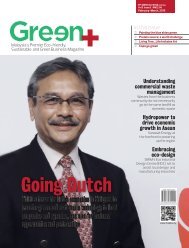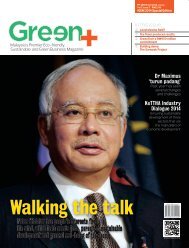Green+ Malaysia's Premier Eco-friendly, Sustainable and Green Business Magazine
SIRIM - Technology Provider
SIRIM - Technology Provider
You also want an ePaper? Increase the reach of your titles
YUMPU automatically turns print PDFs into web optimized ePapers that Google loves.
COLUMN<br />
other species to share the l<strong>and</strong> together<br />
as part of the good practice of biophilic<br />
city design. Aldo Leopold summarized<br />
it well “We abuse l<strong>and</strong> because we<br />
regard it as a commodity belonging to<br />
us. When we see l<strong>and</strong> as a community<br />
to which we belong, we may begin to<br />
use it with love <strong>and</strong> respect.”<br />
WATER<br />
Another hard truth we face in this 21st<br />
century is the global water crisis. Only<br />
0.3% of the freshwater in the world is<br />
readily accessible surface water. By<br />
2025, 52 countries, with two thirds of<br />
the world’s population, will likely to face<br />
fresh water shortage. Water is the blood<br />
of the Earth. It is a vital to all the organisms<br />
who live on Earth as our blood is<br />
to us. An unhealthy aquatic system<br />
can lead to algal blooms, swimming<br />
closures, weed infestations, fish kills,<br />
waterborne illnesses <strong>and</strong> contaminated<br />
ground water. A river will be clean only<br />
if nothing fouls it up in the first place.<br />
With the 300,000 tonnes of garbage,<br />
enough to fill 100 Olympic-sized swimming<br />
pools being dumped into our<br />
Malaysian rivers yearly <strong>and</strong> many other<br />
source of contaminants, what makes<br />
us think that we deserve clean water<br />
after all?<br />
The rules towards a justifiable usage<br />
of water are simple <strong>and</strong> widely known<br />
but only few or none of us practice<br />
them due to our dirt cheap subsidized<br />
potable water, that does not reflect the<br />
true ecological externality cost. The<br />
fact is the built environment we live<br />
in today sees water as a cheap commodity<br />
so much (or even free!), that we<br />
isolate ourselves from the very much<br />
perceived “contaminated” rainwater<br />
for simple h<strong>and</strong> washing for example.<br />
Yet, we hear citizens complaining on<br />
the water shortage while free <strong>and</strong><br />
clean water is pouring down on their<br />
roofs then. We need to regenerate<br />
our cities <strong>and</strong> peoples’ mind sets to<br />
celebrate the availability of water by<br />
harvesting precipitation while allowing<br />
ground water replenishment, by<br />
treating greywater <strong>and</strong> blackwater as a<br />
resource, by enhancing aquatic health,<br />
instead of glorifying our magical water<br />
taps at home. The health of waterways<br />
is important in the health of the entire<br />
ecosystem, including human’s.<br />
ENERGY AND TRANSPORTATION<br />
It is known from Malaysia National<br />
Energy Balance 2012 sheet that the<br />
transportation <strong>and</strong> building sector<br />
accounts for 37% <strong>and</strong> 15% of the total<br />
energy usage. The scattered forms<br />
of development that both urban<br />
<strong>and</strong> rural areas have adopted over<br />
the last 60 years require significant<br />
Good Design: Singapore’s Bishan-Ang Mo Kio Park features water playground which offers a different<br />
outdoor learning experience for its surrounding residential community.<br />
Jeffery Lim (Left), the founder of Cycling Kuala Lumpur Bicycle map, leading a group of cyclist over a<br />
one day tour to rediscover the lost spaces of Petaling Jaya.<br />
transportation infrastructure dependent<br />
on a cheap <strong>and</strong> accessible supply<br />
of energy. Today, we live in an increasingly<br />
mobile world where we expect to<br />
be able to fly or drive outstation over<br />
the weekend. The modes of transport<br />
<strong>and</strong> the high energy dem<strong>and</strong> environment<br />
we live in require large amounts<br />
of fossil fuel, produce air pollution <strong>and</strong><br />
contribute to climate destabilization.<br />
On the contrary on design thought,<br />
how would society <strong>and</strong> our sense of<br />
place be impacted by reduced mobility<br />
<strong>and</strong> recreational activities that<br />
occurred closer to home?<br />
Energy <strong>and</strong> transportation dem<strong>and</strong><br />
can be reduced by creating beautiful<br />
whole communities. Do people feel less<br />
of a need to escape to the countryside<br />
when they have a strong sense of place<br />
<strong>and</strong> attachment to their community?<br />
Perhaps there need to be more places<br />
to escape to within the city, this<br />
includes having access to recreation<br />
in natural spaces, quiet sheltered<br />
repose, vibrant street lie <strong>and</strong> shopping<br />
opportunities among other things. By<br />
designing for integrated communities<br />
with multipurpose infrastructure<br />
<strong>and</strong> encouraging active mobility such<br />
as walking or cycling, there is huge<br />
earning in the aspect of energy conservation<br />
before we even start talking<br />
32<br />
november-december, green+.2014





